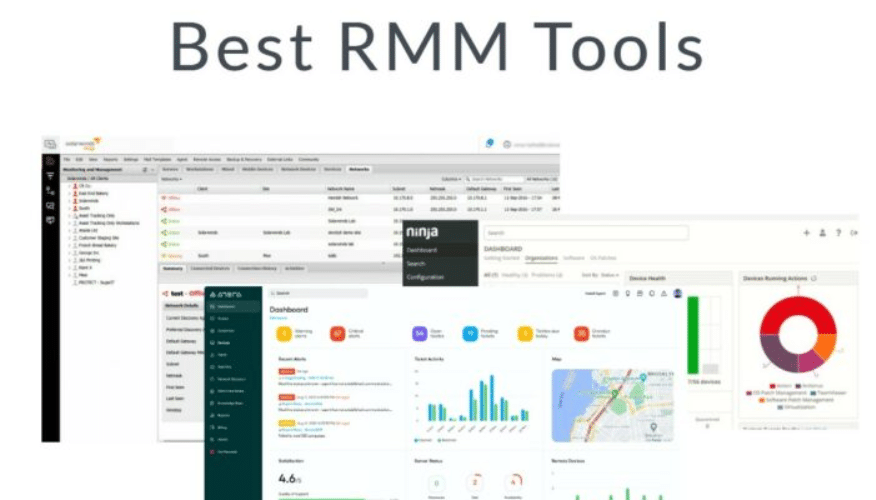managing IT infrastructure remotely has become essential for businesses of all sizes. Remote Monitoring and Management (RMM) tools have emerged as indispensable assets, empowering organizations to oversee and maintain their networks, devices, and systems from anywhere. In this article, we delve into the realm of RMM tools, exploring their functionality, benefits, and how they’re revolutionizing the landscape of remote management solutions.
What Are RMM Tools?
RMM tools, short for Remote Monitoring and Management tools, are software solutions designed to facilitate the remote management and monitoring of IT infrastructure, including servers, workstations, mobile devices, and networks. These tools enable IT professionals to proactively monitor, troubleshoot, and manage various aspects of an organization’s IT environment, ensuring optimal performance, security, and reliability.

RMM tools encompass a wide range of functionalities, such as remote desktop access, patch management, software deployment, asset inventory tracking, security management, and automated alerts and notifications. By providing real-time insights and control over IT assets, RMM tools empower businesses to enhance efficiency, minimize downtime, and mitigate security risks.
The Evolution of RMM Tools
Over the years, RMM tools have evolved significantly to meet the evolving needs of businesses in an increasingly complex IT landscape. Initially focused on basic monitoring and remote access capabilities, modern RMM solutions offer advanced features and integrations to address the diverse challenges faced by IT professionals.
Today’s RMM tools leverage technologies such as artificial intelligence (AI), machine learning (ML), and predictive analytics to deliver predictive maintenance, anomaly detection, and proactive issue resolution. Additionally, cloud-based RMM platforms have gained prominence, offering scalability, flexibility, and accessibility for organizations of all sizes.
Key Features of RMM Tools
Remote Monitoring:
RMM tools provide comprehensive visibility into the health and performance of IT infrastructure, allowing IT teams to monitor vital metrics, such as CPU usage, disk space, network traffic, and system uptime. Real-time monitoring enables proactive identification of issues and performance bottlenecks, minimizing downtime and optimizing resource utilization.
Remote Management:
One of the core functionalities of RMM tools is remote management, enabling IT administrators to perform various tasks, such as software updates, configuration changes, troubleshooting, and maintenance activities, without physically accessing the devices or systems. Remote management capabilities streamline IT operations, reduce travel costs, and improve response times for support requests.
Patch Management:
Effective patch management is crucial for maintaining the security and stability of IT environments. RMM tools automate the process of deploying security patches, updates, and software installations across multiple devices and endpoints, ensuring compliance with security policies and regulations. Patch management functionalities help organizations mitigate vulnerabilities and safeguard against cyber threats.
Security Management:
Security is a top priority for businesses in today’s threat landscape. RMM tools offer robust security management features, including antivirus and malware protection, intrusion detection, firewall management, and security policy enforcement. By proactively monitoring for security incidents and vulnerabilities, RMM tools help organizations bolster their defenses and safeguard sensitive data.
Automated Alerts and Notifications:
RMM tools provide proactive monitoring and alerting capabilities, notifying IT administrators of critical events, system errors, performance issues, and security threats in real-time. Automated alerts enable prompt identification and resolution of issues, minimizing downtime and ensuring uninterrupted business operations. Customizable alerting mechanisms allow IT teams to prioritize and respond to incidents effectively.
Benefits of RMM Tools
Enhanced Efficiency:
By automating routine tasks, centralizing management, and providing real-time insights, RMM tools enhance the efficiency of IT operations, enabling organizations to accomplish more with fewer resources. Streamlined processes, proactive maintenance, and remote management capabilities contribute to increased productivity and reduced operational costs.
Improved Security:
RMM tools play a pivotal role in enhancing cybersecurity posture by monitoring for security threats, enforcing compliance policies, and facilitating timely patching and updates. By strengthening security defenses and minimizing vulnerabilities, RMM solutions help organizations mitigate the risks of data breaches, malware infections, and other cyber attacks.
Scalability and Flexibility:
Cloud-based RMM platforms offer scalability and flexibility, allowing organizations to adapt to changing business requirements and IT environments. Whether managing a handful of endpoints or a distributed network of devices across multiple locations, RMM tools provide scalability without the need for significant infrastructure investments.
Proactive Maintenance:
With predictive analytics and proactive monitoring capabilities, RMM tools enable organizations to anticipate and prevent IT issues before they escalate into critical problems. By identifying trends, anomalies, and performance bottlenecks, RMM solutions empower IT teams to take preemptive actions, minimizing downtime and maximizing system reliability.
Centralized Management:
RMM tools centralize the management of IT infrastructure, providing a single pane of glass for monitoring, configuration, and troubleshooting activities. Centralized management streamlines IT operations, improves visibility and control, and simplifies the management of distributed environments, regardless of size or complexity.
Cost Savings:
By optimizing IT operations, automating repetitive tasks, and reducing downtime, RMM tools deliver tangible cost savings for businesses. The efficiencies gained through remote management, proactive maintenance, and security enhancements translate into lower operational expenses and a higher return on investment (ROI) for organizations.
FAQs (Frequently Asked Questions)
- How do RMM tools improve security?
- What are the key features of modern RMM solutions?
- Can RMM tools be customized to suit specific business needs?
- How do RMM tools facilitate remote troubleshooting?
- Are cloud-based RMM platforms more advantageous than on-premises solutions?
- What factors should businesses consider when selecting an RMM tool?
Conclusion
In conclusion, RMM tools have emerged as indispensable assets for businesses seeking to optimize IT management, enhance security, and drive operational efficiency. By leveraging advanced technologies and automation capabilities, RMM solutions empower organizations to overcome the challenges of remote management, mitigate security risks, and achieve their business objectives with confidence.
Embrace the power of RMM tools and unlock the full potential of your IT infrastructure, empowering your business to thrive in today’s digital landscape.